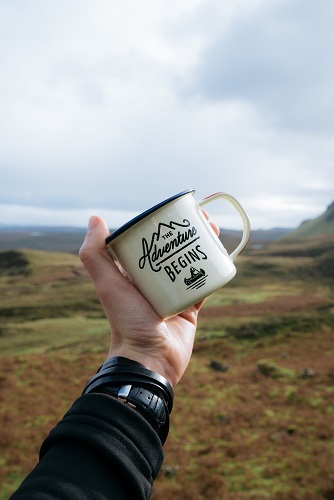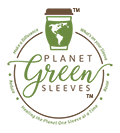How it Began

It really all started because of repeated visits to the local coffee shop. I would stand in line waiting to order my daily cup of dark roast, and upon taking the cup in my hand, I couldn’t walk fast enough to the counter near the exit to set it down, grab some napkins out of the dispenser, and wrap them around my cup to be able to walk to my car without annoyance. Then one day, after many visits with the same experience, I returned to my Real Estate and Mortgage office and sat down to work out a solution. There in front of me, scattered around my desk, were the remains of cups and sleeves from a few of my prior visits. I looked at the sleeves and started to manipulate them in a fashion that could provide for better heat resistance and hold. I tore the sleeves open, wrapped and taped them until a new form started to take shape; I can’t say what compelled me to take it home that evening, but I did.
When I arrived home, I took a stack of candles and melted them in a saucepan. Then, I looked around the place trying to spot an item matching the image I had in my head and which would also allow for a good grip. In my cupboard, I spotted an hourglass-shaped metal tumbler; I dipped it into the melted wax multiple times letting it dry with each set. It took the shape I had envisioned, but now I wondered what to do next. Using online resources, I started exploring what was needed to have a design made and then up popped a search result with an abbreviation CAD (Computer Aided Design). While this was a new word for me, the explanation was good enough that it directed my next step. I then searched online postings for users that had CADs made of their ideas. After reaching out to one CAD company and after multiple visits refining the size and shape, I was told a 3D printed cast could be made that would allow a liquid material to be poured into it that would set up overnight and take the shape of the CAD design.
More searches were underway to find a material for the project. I knew that Hobby Shops carried different materials appropriate for this project, but I wasn’t sure which material was best. Eventually, I found a local supplier and paid them a visit. This local retailer pointed me in the direction of the type of materials I should be using to obtain the malleability attribute it possesses today—they called this a Shore Hardness factor, another new word. I described it as needing to be squishy, silly putty-like in feel but firm enough to stand on its own once taken shape.
I was told to try three different materials for the tactile feel I was wanting to experience with it. In doing all of the preparation for mixing (it required rubber gloves, goggle, disposable mixing containers, paint can stir sticks and a lot of wax paper to handle dripping due to the overfills and spills), many nights of testing given the 12-hour set-up time and also the delay in breaking the 3D molds when trying to pry away the two parts of the cavity and separate the core of the 3D mold only to have to have others made as a result of initial trials—lo and behold, I was able to find the right combination of materials that gave the very look and feel I had first envisioned.
Now the question was, what was I going to do with it…. First, I considered these 4 questions:
- Do you have an idea, innovation or invention?
- Do you think it has commercial value?
- Can it be made, marketed and sold for a profit?
- Do you want to get it into the center of its marketplace, so it can serve humankind and make you money?
The resounding answer was YES to all 4. It was then that I felt there was a chance, that this could be real, that it could, in fact, be something that people would want, would see the value in. The technology for manufacturing was certainly there, so with that CAD design in hand I started my journey into visiting many companies. Some gave me the time to investigate the possibilities, most that did saw there may be an opportunity to take advantage of my naivety while others simply dismissed me without even taking the time to quote. It took many trips to manufacturers getting schooled along the way on how to conduct myself in business and set expectations of what a fair price should be that was commensurate with the tool design. Left with the frustration of knowing I was unable to fork out the money they were quoting, I had to think more creatively. Being the perennial optimist that I am and thanks to many online invention related searches, I came across North America’s Largest Invention Expo that was to be held in Pittsburgh, PA.
I wrangled enough money to obtain a booth, had 3 impressive pop-up banners made, created slideshows of my story and computer-generated renders with imaging more like I envisioned, made as many rudimentary sample sleeves as I could with the weakest looking stamped on 1 color print applications and flew off to the Expo thinking, This is going to be the next best thing since sliced bread. I will win the “Best Invention” idea and be awarded prizes, cash, and win the attention of multimillion-dollar investors…lol… NOT… but… I did make a contact there that allowed me the ability to obtain prototypes from his connections that were made from a temporary, yet durable enough mold that produced about 50 very nice samples.
Concurrently, I was looking into a multitude of print method applications to bring this form with its unique and oddly shaped contour (at least for printing purposes) to production. Let’s just say good print application is best on flat surfaces and if cylindrical, at least let it be an even shape at that… mine, on the other hand, was anything but…lol.
I eventually discovered that a method called PAD printing could, in fact, work but…. it was not what I had envisioned. PAD printing is typically done in no more than 1-2 color 1-2 sided logos. So it couldn’t provide the first-rate product with quality digital, photo-realistic images that I envisioned providing to business customers and the public. That was not going to work.
I also discovered PAD printing and many other methods require somewhat expensive equipment and preparation, which would immediately drive the overhead price up making it too cost prohibitive to bring this to market. My journey continued on to many visits to printers far and wide. It was through the extensive travels, enduring so many “noes,” “can’t do its,” and “not possible” statements that I was finally referred to a company that might have the solution I was seeking. Fortunately for me, the company’s representative would be visiting my hometown the following week. A meeting was scheduled at my manufacturer’s plant where we stood at the conference table pondering what could be done and whether it was possible.
I can’t say what compelled the printer rep to say, “Just send it to my headquarters, and I will test it when I get back into town,” but that is exactly what he said. I shipped it in advance of his return and was notified a short time later that it was a go, but…
The testing was done on a material that did not meet the standards of what they would call passing the “Scratch test” to allow for durable, long-term ink adhesion or the thermal effect I was looking for as well. I do not believe in doing something halfway in life, so why start now? It would have been easy for me to justify it was good enough after so much traveling, time, money, doors closed to just say we’re there, finally, after all this time but…it was not going to happen. I pushed on to find a better material that would meet the standards I wanted the public to experience. I did not wish to bring what could potentially be a global product to market and have it be perceived as just another unnecessary plastic-looking, foam-feeling object thing that would get put away in the back of a cupboard. I pressed on working with my manufacturer to source a material that would allow for not only having the long-lasting ink adhesion but strength and durability to withstand thousands of uses given the pliable nature of its inherent flexible composition.
Another challenge was faced but why stop now right, there had to be an aligning of planets and stars wherein the material would have all that was wanted AND at a price that it could be manufactured in a way that would allow for it to go into so many markets, reach so many audiences and, if successful, impact the environment in a more positive way. So, I committed to taking more time towards sourcing, researching, and testing until the right material was found.
Nothing less than a miracle really, so many people along the way, so many roads and directions taken (many down a closed path), so much time spent waiting to be able to move it forward again, so much traction lost as a result, and yet, I reflect back and think, the time was not right, the people and companies that I had to be working with were not in my life, we simply were not in alignment nor shared or saw the same vision and dream. But… we are here now and here to stay, to bring our product to the world as first envisioned.
I humbly offer Planet Green Sleeves to you and the world.
